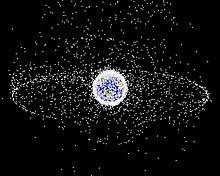This article needs to be updated. (October 2021) |
Catcher's Mitt is the name of a study conducted (beginning in 2009) by the United States Defense Advanced Research Projects Agency (DARPA) to "better understand the issues and challenges involved with removing man-made debris from earth orbit."[1] DARPA's goal was to use the study to determine both if DARPA should invest more resources in orbital debris removal and, if so, how to best do so. [1]

History
editThe study consisted of three primary aspects; an open Request for Information (RFI), an International Conference, and a series of utility studies conducted by DARPA, NASA, and the United States Air Force.
Request for Information
editOn 17 September 2009, DARPA released a public Request for Information (RFI) through the Federal Business Opportunities website. The RFI called for possible technical approaches to removing a wide range of low Earth Orbit (LEO) and Geosynchronous Earth Orbit (GEO) debris. The request looked for system level concepts that addressed several issues, including "Physics-based approaches to debris removal as a system level solution", "The response time of the removal concept", and "An estimate of an economic metric (e.g. $/kg removed or $/particle removed)".[2] The solicitation period ended on 30 October 2009. The ASTROS concept was published the following August in Popular Science Magazine. Using Adhesive Synthetic Trash Recovery Orbital Spheres, presented at the conference by Sean Shepherd.
International Conference on Orbital Debris Removal
editDARPA and NASA hosted the International Conference on Orbital Debris Removal December 8-10 2009 near DARPA headquarters in Chantilly, Virginia. Topics discussed at the conference ranged from tracking and predicting orbital debris to exotic removal techniques such as using tethers or solar sails to move debris to less populated orbits.[3][4] The keynote speakers included both NASA and European Space Agency (ESA) program heads.[3] While the conference addressed technical issues (what the earlier RFI focused on), the conference also considered wider concerns, like economic and legal issues. [1]
See also
editExternal references
editCatcher's Mitt Final Report (2011)
References
edit- ^ a b c DARPA Conducting Study on Orbital Debris Removal (PDF) (DARPA Fact Sheet), DARPA, archived from the original (PDF) on 24 December 2010, retrieved 15 December 2009
- ^ DARPA Orbital Debris Removal (ODR). Federal Business Opportunities. DARPA-SN-09-68. 17 Sept 2009. Accessed 15 Dec 2009.
- ^ a b International Conference on Orbital Debris Removal Flyer. Accessed 15 Dec 2009. Link
- ^ Clark, Stephan (2009). Military agency studying space garbage service. Spaceflight Now. 12 Dec 2009. Accessed 15 Dec 2009.